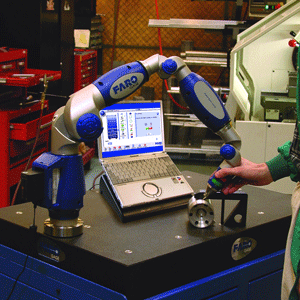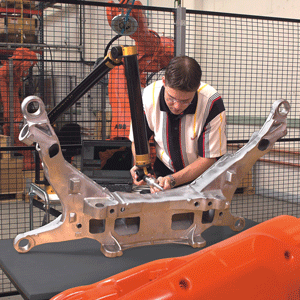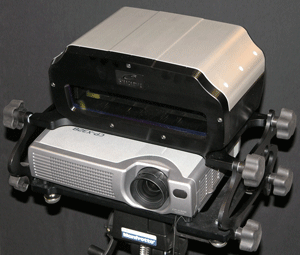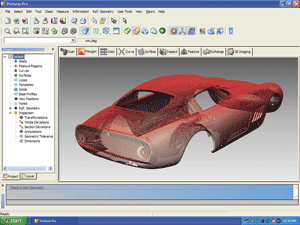Low-Cost Digitizers Collect 3D Data
You don't need deep pockets to add 3D data gathering or reverse engineering toyour company's CAD/CAM toolbox.
Latest News
December 1, 2004
By Pamela J. Waterman
A Man and His Tools: It’s a Beautiful Thing. You’ve seen the T-shirts and baseballcaps. They highlight the insatiable appetite men (and women) have for new, ever-more-refinedtechnical capabilities—and if we can get them affordably, all the better. That’sthe case with many of today’s 3D digitizers, the tools for gathering data thatultimately defines a 3D CAD file of a physical object. This article looks at avariety of systems that address the task formerly known as reverse engineering,yet cost less than $30,000. |
| FARO Technologies’ Gage-PLUS portable coordinatemeasurement machine (CMM) is designed for machine-shop use. Thesystem comes with a rugged laptop and is ready to use out of the boxwithout training. |
Take Your Pick
Four years ago we examined “camera-based” and “mechanical-based” systems as away to categorize 3D digitizing systems (DE November 2000). Since then, techniqueshave blended; acquisition speed, resolution, handling, and processing have improved;and some vendors now offer a range of technologies, all in pursuit of the bestapplication fit. Following are simple details of some current systems; use themas starting points for comparisons, and be sure to ask about resolution and accuracy.
Cyberware
The M15 Desktop 3D Scanner ($28,600) uses a laser and charge-coupled device (CCD)sensors to capture an object’s shape in about 17 seconds (speed is customer set).The price includes CyDir software for scanning control, part rotation, multiple-scanmerging, and measuring and editing capabilities. The Model 15 has a rotating bedand can scan parts up to 10 in. x 6 in. x 3 in.; scans generate 250,000 points.
 |
| The ROMER STINGER II is used to digitize points that will be used to programa robot to machine flashing from a casting. |
FARO Technologies
Faro recently introduced two “personal” battery-powered CMMs, the Gage ($12,500)and Gage-PLUS ($19,900), offering accuracies of 0.0004 in. and 0.0002 in., respectively.No training is required for use, and results are shown as tabular and graphicalreports.
Immersion
The MicroScribe MX is Immersion’s family of lightweight CMM arms. There are eightversions ($3,495 to $11,995) with basic driver/calibration software and two probetips.
Inspeck
Inspeck offers two systems based on halogen light projecting a Moiré fringe pattern,with cameras detecting fine fringe shifts. The 3D Capturor II ($13,000) uses adigital camera—sold in small field (SF) or large field (LF) versions—that takes300,000 samples, while the 3D Mega Capturor II ($16,000; also SF or LF) capturesmore than 1.3 million points. Acquisition time is 0.4 seconds, and both modelsprovide color and texture data. Included is software for fringe acquisition, editing,and merging; multiple cameras can work together.
 |
| VX Technologies’ FW-3R camera uses an LCD projector to enable use under low-contrastconditions. |
Konica Minolta
The optics specialists manufacture a basic VIVID 910FW ($23,800) laser/colorCCD camera system, offering a choice of one of three lenses for telephoto, mid-range,or wide-angle applications. The largest possible scanning volume (with the wide-anglelens) is 50 in. x 38 in. x 16 in., and multiple scans can be saved to the internalcompact flash memory (a rear-panel LCD allows immediate scan viewing). The fastestscan mode takes 77,000 points in 0.3 seconds, while fine mode generates 307,000points in 2.5 seconds.
Polhemus
There are two versions of the handheld FastScan laser “wand”: the single-cameraCobra ($19,995) and the faster processing, dual-camera Scorpion ($25,995). Anoptional touch stylus ($700) yields distance measurements on the user’s PC screen.With a unique electromagnetic tracking system, the FastScans work on nonmetallicobjects only. Additional processing software for filling holes and simplifyingmeshes costs $1,995.
Roland DGA
Roland markets two laser-based systems, the LPX-250 ($9,995) and LPX-1200 ($21,995.)The LPX-250 scans a 10 in. dia. x 16 in. high volume, with up to 0.008 in. resolution;the LPX-1200 has a maximum 5 in. dia. x 8 in. high volume, but with a 0.0039 in.resolution. Pixform Pro reverse modeling software is included, with align, merge,fill, decimate, remesh, and translate capabilities.
Roland DGA also sells four systems based on touch probes with activepiezo sensors.The PICZA PIX 4/30 pair ($1,995/$3,495) differ in their scanningvolumes: 6 in. x 4 in. x 2.4 in. or 12 in. x 8 in. x 2.4 in. TheMDX-15/20 pair ($2,995/$4,495)combine scanning and computer numerically controlled (CNC) millingfunctions onone machine, offering work volumes of 6 in. x 4 in. x 2 3/8 in. or 8in. x 6 in. x 2 3/8 in.
 |
| After using the Roland LPX-1200 to scan a car model,the digitized model is edited with Roland PixForm Pro reverse modelingsoftware. |
ROMER CimCore
The STINGER II portable CMM arm ($19,900) includes three quick-change probesand the HighRes digitizing software package. Optional PowerINSPECT software ($11,000)includes CAD-to-part comparison functions, with three days of training for twopeople at ROMER headquarters in Farmington Hills, Michigan.
SCANTechnology
SCANTechnology supplies its CARSO/Basic OneCam 3D laser head ($10,000) for mountingon your CNC machine, creating a laser-scanner copying system. SmartScan CAD/CAMsoftware (included) is optimized for using the acquired data to drive a CNC machine,but it also triangulates the point cloud, decimates it, and registers scans together.Speed is more than 6 ips. Higher-end CARSO systems sell for less than $20,000.
VX Technologies
With 15 years of experience in nonlaser stereoscopic triangulation, VX Technologiesbuilds on its background with its StarCam FW-3R digital imaging system ($18,780).The base system includes the camera, tripod, mount, software, and a third-partyLCD projector to assist in low-contrast situations. Acquisition time ranges from0.75 to 20 seconds, depending on resolution; scans typically acquire 170,000 points.
Details, Details
It’s tempting to categorize 3D digitizing tools by their underlying technologies,but look past the form to match needs with function. Are you looking for an appearancemodel or dimensional data? Do you require fine detail on small objects? Is acquisitiontime an issue, and does it include bringing up the full image on a host computer?Can you get color data?
Other points to consider: When talking resolution, be aware that the axes aresometimes (but not always) referenced with x as the horizontal dimension, y alongthe vertical axis, and z as the distance from the sensor, and the resolution alongeach axis may differ. Accuracy may also vary with the distance between the objectand the sensor. Check whether and when recalibration is required.
Ask if a PC (with what connector) is required to run the system; FARO includesa laptop in its price, while the Konica/Minolta model needs no PC to perform acquisition,using a built-in LCD viewfinder and compact flash memory. See if the processingsoftware just accumulates points or actually allows filling in holes, adding thickness,or editing out tooling supports. Will it export to your CAD software?
View the Chart: Reverse Engineering: Hardware Resources
The wrong tool for the job does no good, so take time evaluating them, especiallyif your needs may change down the road. Though small parts may comprise your currentbusiness, will the system accommodate larger items if you need it to? Or, thoughthe schedule for your current projects may easily handle swapping out probes forscanning heads on a CMM, will a new program require a dedicated digitizing system?
All the vendors contacted for this article are genuinely interested in makinga good match. Do your homework, then congratulate yourself on finding a low-costsolution to a high-tech problem and gaining a very cool tool.
Contributing editor Pamela J. Waterman is an electrical engineer and a freelance technical writer based in Arizona.You can contact her about this article via e-mail c/o [email protected].
Seamless Part Digitizing to Machining
A partnership between Surfware, Inc., of Westlake Village, CA, and FARO Technologieshas resulted in a new feature in SURFCAM that supports FaroARM products. As aresult, the service pack in SURFCAM lets you use any FARO 6-axis or 7-axis portabledigitizer as an auxiliary pointing device to input 3D coordinate data into anactive SURFCAM session. It makes for a seamless part digitizing-to-machining solution.
SURFCAM captures the dimensional data and the FARO portable measurement armsprovide the interface to the CAM program. It also allows SURFCAM users to freelyintermix digitized input with all other input modes to facilitate model creation,toolpath generation, and material removal simulation in a single environment,continuously displaying the FaroARM probe tip for graphical verification.
“Users can create, edit, generate, and simulate toolpaths, then machine complexsurface models all in a single setup without any file transfers,” says Don McKillop,president of CAM/CAD Technologies.
This interface now supports both serial and universal serial bus (USB) connectivity,enabling the system to work with legacy and current FARO equipment. It includesa variety of convenient coordinate alignment techniques, probe calibration, probechanging within a session, system diagnostics, and a series of convenient digitizingmodes. Digitizing modes include discrete point input, lock-plane input, streaming-coordinatemode input, and project-onto-plane input.
Other Pricing Options
We chose $30,000 as the price ceiling for this article, but there are many systemsin the $40,000 to $60,000 range, and others more sophisticated and expensive.A little more cash outlay might give you exactly what you need without compromise.Moreover, used systems made up of high-end equipment can sometimes be purchasedfor under $30K.
Companies Mentioned
Surfware, Inc.
Faro Technologies
Cyberware
Immersion
Inspeck
Konica Minolta
Polhemus
Roland DGA
ROMER CimCore
SCAN Technology
VX Technologies
Subscribe to our FREE magazine, FREE email newsletters or both!
Latest News
About the Author
Pamela Waterman worked as Digital Engineering’s contributing editor for two decades. Contact her via .(JavaScript must be enabled to view this email address).
Follow DE





